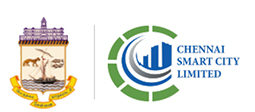Vanian Kulam (Sannathi Street)
Vanian Kulam pond was an old water resource used by the oil vendors in the area long ago. Then as the area was subjected to developments and changes, the pond was abandoned. When this water body was identified by GCC, it was evident that the pond had the potential of in-situ catchment. Now the pond is fully restored under the Chennai Smart City Project funds.
AREA: 3237.4880000000003 Sq.mtrs ZONE: 2 DIVISION: 21
This pond is in Division 21 of Zone 2 and is on the Sannathi Street. It is located at the end of Anbazhagan Street and to the west of Sannathi Street. The pond lies in North Latitude 13 9'57.69" and East Longitude 8015'39.42".
The pond is roughly rectangular in shape. There is no water in the pond during the time of survey. The pond is neither provided with revetment nor with steps . At present, there is no specific catchment to the pond but for its own in-situ catchment. There is no inlet or outlet to the pond provided. The area around the pond is fully urbanized. Based on the interaction with the local community, it is inferred that the pond use to hold water for about 6 months in the past, whereas now it holds only for 2 3 months in a year. In the past, the pond water was used for washing and bathing by the local community and at present it is not used. The entire bund is encroached. The water spread s under encroachment. The pond is dumped with solid waste and also with liquid waste from the surrounding houses. The pond bed is observed to be sandy favoring fast percolation of pond water into the ground. Based on the Total Station Survey output, it is inferred that the total area of the pond is 3,300.04 sq.m and the total length of the bund is 252.83 m. The average depth of the pond is about 2.5m.
The imagery extracted from google earth on 07.02.2017 and 18.02.2012 is presented below a definite change in the water spread. Also the vegetation on the bund has been removed which is evident of the bund being encroached all around the pond.
Google Image of the pond as on 07.02.2017 (LEFT) and 18.02.2012 (RIGHT)
The actual volume stored in the tank during 1987 a normal rainfall year - after losses due to evaporation and recharge is given in the following Graph
The total storage of the tank in its present condition is estimated at 8,698.9 cu.m Based on this estimate, there will be water available in the pond for almost 119 days in a year. At no point of time, the pond overflows in a normal rainfall year. The total inflow to the tank in a normal rainfall year is estimated at 5,117.77 cu.m; the total groundwater recharge will be 3,613.13 cu.m. The estimate was made in an excess rainfall year ie., during 2005 to see the inflow and outflow status. The actual volume stored in the tank after losses due to evaporation and recharge is given in the following graph.
Based on this estimate, there will be water available in the pond for 268 days. The pond in its present volume does not over flows even in an excess rainfall period for the assumed catchment. The total inflow to the tank in an excess rainfall year is estimated at 6,048.50 cu.m; the total groundwater recharge is 2,080.3 cu.m.
Based on the field observations and inferences, followed by the data analysis, following were the list of activities proposed for renovating the Pond.
- The community need to be sensitized first on the importance of water bodies and their role in sustaining the groundwater sources in the area.
- Further encroachment should be checked first by erecting a compound wall around the water body.
- Temporary and semi permanent structures erected on the bund and water body should be removed and cleared.
- Dumping of solid waste should be stopped with immediate effect with a sigh board warning on the polluters / violators with serious consequences.
- Sullage diversion should be checked with the introduction of soak pits at the households that pollutes the pond by diverting it into the pond.
- The pond should be desilted
- After completing the above tasks it is better to retain the water body as such for 1 year, after which the water body can be converted into a water harvesting and recharge system. Introducing recharge system at this stage would lead to the pollution of groundwater and hence it is not recommended. Bund formation, provision of revetment and steps can be considered after stopping sullage diversion and removal of encroachment



